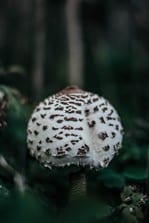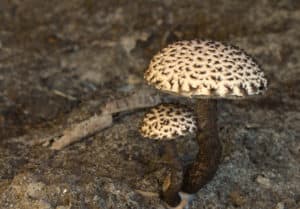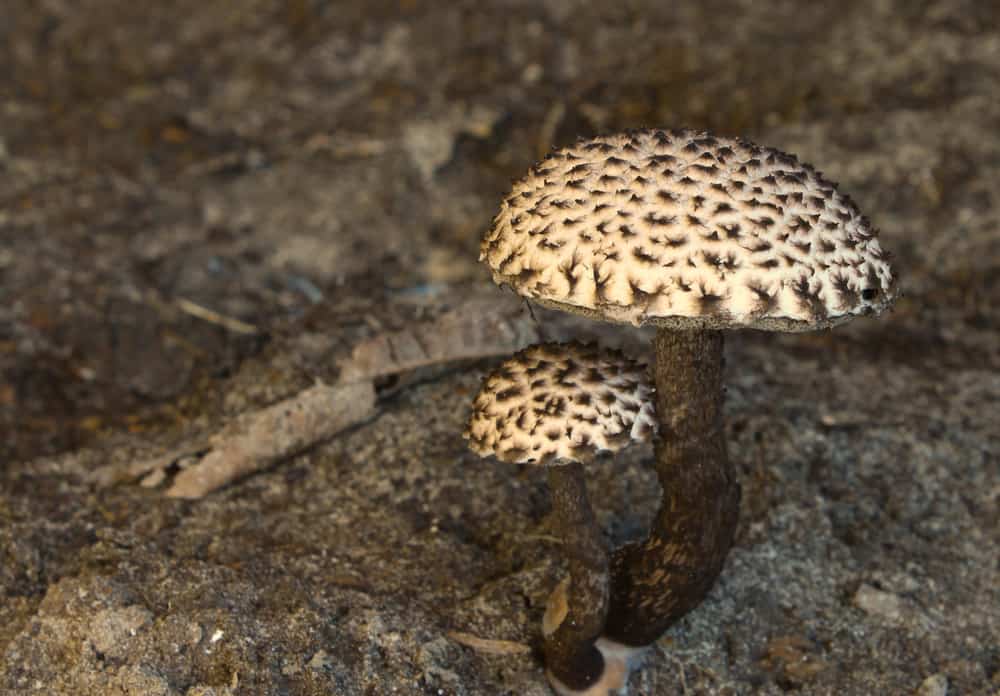Old Man of the Woods Mushroom Guide – An Edible & Wild Mushroom

If you’ve learned how to forage mushrooms and have stumbled upon one that looks like a pine cone on your adventure, there’s a chance it’s the Old Man of the Woods mushroom. Its eccentric name comes from the resemblance to an old man residing in the woods. However, its initial, scientific name Strobilomyces Floccopus translates to ‘wooly mushroom that resembles a pine cone.
When sliced open, the species’ naturally white flesh becomes red-pink and slowly turns black after about an hour. Without further ado, let’s explore everything you need to know about this unique mushroom species.
Image: Close-up mushroom
Where Can You Find the Old Man of the Woods Mushroom?
The unique species particularly fruits in the Eastern region of North America from July to October but is also prevalent in Europe. You’ll typically find it growing on the floor of mixed hardwood forests such as oak trees and, at times below a conifer.
The Old Man of the Woods mushroom is also common in alpines and mountain ranges. It hardly grows in lowlands. Unlike other species that grow in clusters, Old Man of the Woods grows as single mushrooms and blends in with fallen leaves. For that reason, its scientific name alludes to its close resemblance to a rotting pine cone than a mushroom.
How Do You Identify the Old Man of the Woods Mushroom?
It’s an edible yet unique mushroom species with a convex-shaped cap and measures one to six inches in height. Old Man of the Woods is white, dry, and layered with gray-black wooly scales that resemble tufts of hair. Rather than gills, the underside of the cap is peppered with pores. The mushroom stem has a fine layer that mimics dark fur.
When the mushroom is sliced open, the originally white flesh becomes pink before turning black within an hour due to oxidation after exposure to the air. As with any wild mushroom, we recommend roping in an expert to confirm its species when in doubt. The last thing anyone needs is accidentally cooking a poisonous look-alike that can adversely impact your health.
How to Cook an Old Man of the Woods Mushroom

The species is best picked when young rather than fully matured and shouldn’t be eaten raw. You can cook it just as you would grocery store mushrooms by sautéing it in garlic and butter or adding gravies or soups for a burst of flavor that can be described as earthy and mellow.
You might want to confirm whether the Old Man of the Woods mushroom is a rarity in your area. If so, consider letting it grow and propagate as opposed to picking it. Given that it lacks a unique taste, you may want to leave it and forage more common types of mushrooms.
Is the Old Man of the Woods Mushroom Good For You?
While there are no clinical studies that particularly identify the Old Man of the Woods as providing numerous health benefits, as with most types of mushrooms, they are healthy. For instance, mushrooms are low in sodium and calories, free of cholesterol and fat, and rich in minerals, fiber, and vitamins.
Additionally, they possess anti-tumor and antioxidant properties, brain-boosting power, and other medicinal perks. Therefore, you can’t go wrong with mushrooms that also infuse flavor and a boost of texture to any meal.
Old Man of the Woods Mushroom Look-a-Likes
As a species that’s easy to identify, the Old Man of the Woods mushroom stands erect with dark fluffy or wooly, scaly tufts that cover the cap. Therefore, if you notice gills, there’s a chance it’s a poisonous look-a-like that should be avoided. It’s worth noting that a pinched cap underside coupled with blue bruises could be the poisonous Boletus.
Boletus is a type of mushroom characterized by the lack of gills on the underside of the cap. The genus comprises more than 100 separate species and contains a wealth of flavorful and edible members. Nonetheless, there are a few poisonous and bitter counterparts.
Other species that might be mistaken for Old Man of the Woods are the smaller-caped Strobilomyces and the Dryophilus with a pink-grey cap. When in doubt, always consult an expert mycologist.
Side Effects and Toxicity of the Old Man of the Woods Mushroom
The species has no scientific reports that indicate its toxicity. Nevertheless, always proceed when trying out a new type of mushroom for the first time. Furthermore, if doubt creeps in, seek medical advice before consumption.
Preparation
If you have the Old Man of the Woods mushroom in your kitchen, you might be a tad curious as to how to prepare it. We suggest replacing ¼ of the generic grocery store mushrooms in a soup for a start. Doing so enhances the mushroom flavor, aroma, and texture while imparting a wilder taste compared to the ‘tame’ white mushrooms.
Recipe: Hungarian Mushroom Soup
Here are the step-by-step instructions of a recipe you can try out using the Old Man of the Woos mushroom.
- Melt 3 tablespoons of unsalted butter in a large pot on medium heat
- Sauté 2 diced onions in the butter for 5 minutes
- Add 1 lb of freshly sliced mushrooms and sauté them for 5 additional minutes
- Add 1 tablespoon of paprika, soy sauce, and dried dill weed
- Reduce the heat to low, cover the pot and allow the mixture to simmer for up to 20 minutes
- Whisk 1 cup of milk, and 4 tablespoons of all-purpose flour, then add it to the pot
- Stir the mixture well and let it simmer for 15 minutes, making sure it doesn’t boil
Conclusion
Foraging mushrooms sustainably in the wild paves the way for you to combine fresh air, exercise, and adventure all in one. You also get the gratification of finding food to cook for your next meal. Although it’s not as popular as other species, the Old Man of the Woods mushroom is worth keeping an eye out for as you explore the wild.




